What Are The 5 Most Common Microphone Pickup Patterns?



What are the Pickup Patterns of a Microphone?
There are hundreds, potentially thousands of microphones available. These are primarily sorted into pickup patterns. When you go to purchase a microphone, the desired pickup pattern is likely to be your first question.
The pickup pattern describes how the microphone captures sound from various angles.
What is the Polar Plot of a Microphone?
The pickup pattern of a microphone is illustrated using a polar plot like the one below. The curve(s) in these plots show how the signal drops off as you move further and further away from the centerline of the microphone. As each microphone responds differently as the frequency changes, a good plot will show separate curves for different frequencies.

Typical Polar Plot
These polar plots are somewhat confusing because the signal level is in decibels (dB), which is a logarithmic scale. When the sound is half as loud, the decibel (dB) level will decrease by 6 not by 2.
To the left is a typical polar plot depicting a cardioid pickup pattern. To be truly useful, the plot should supply data for various frequencies as the pickup pattern will vary significantly from high frequencies (high-pitch sounds) to low frequencies (low-pitch sounds).
An example of such a polar plot is shown on the right. This particular chart is provided by Sennheiser for its ME67 shotgun microphone.
Such plots are available for every different microphone, but they tend to fall into one of several typical patterns. These typical patterns are Omnidirectional, Cardioid, Supercardioid, Hypercardioid, Lobar, and Figure 8. We will discuss each of these distinctive patterns, as well as one more uncommon pattern.

Microphone Pickup Patterns: Omnidirectional
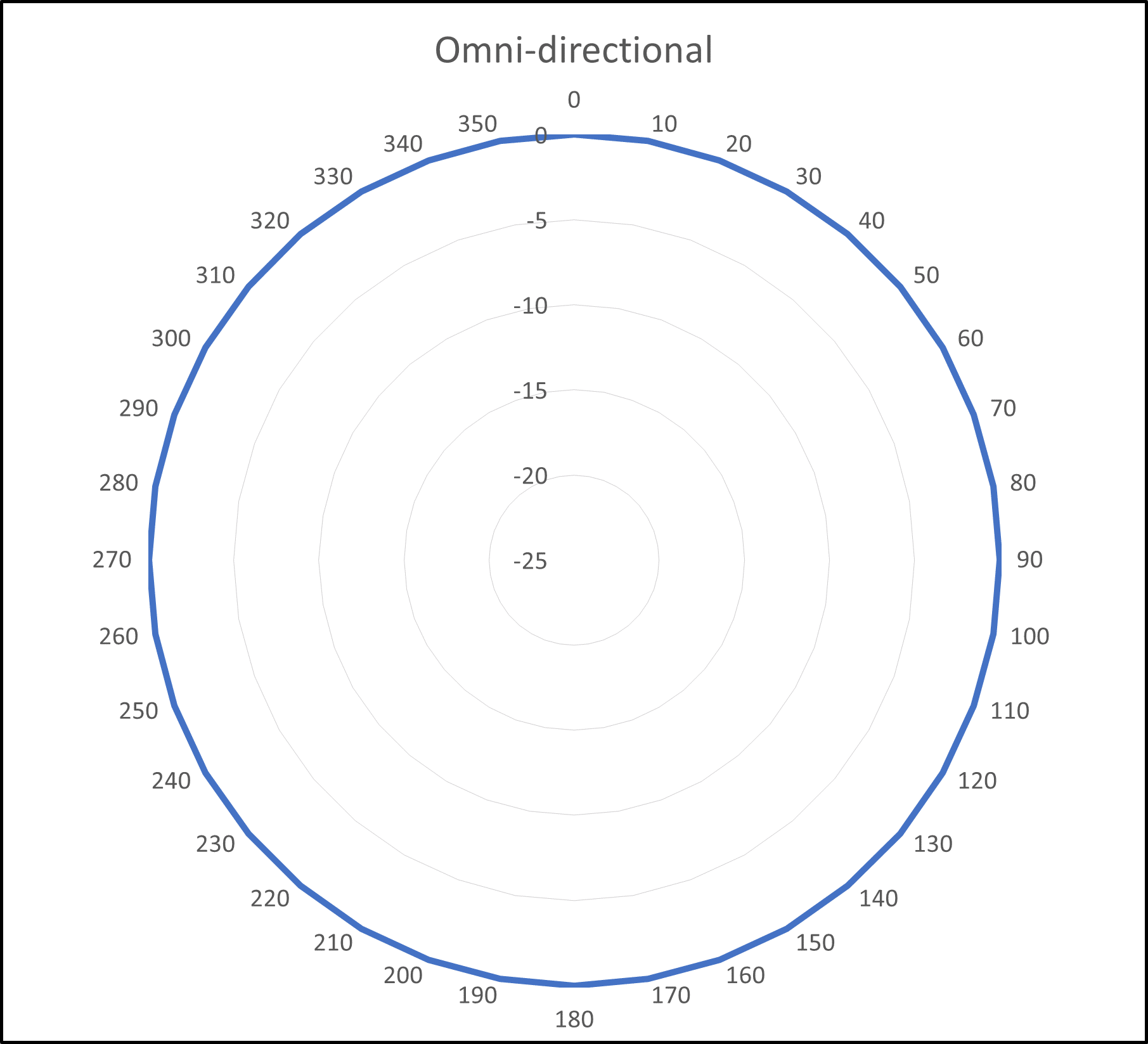
Omnidirectional Polar Pattern
(Gain in dB)
As you may have guessed, an Omnidirectional microphone, captures audio at equal levels from all directions. The image on the right shows an Omnidirectional polar pattern. The blue curve shows that the signal level doesn’t change as you move away from the centerline of the microphone.
Let’s imagine being in the center of a large room with people standing in a circle around you. Each person is exactly six feet from you. An Omnidirectional microphone would pick up each person at the same level. The image on the right shows how these people would sound to the microphone. The red dot is the microphone, and each person standing around the microphone represents a blue dot. To the mic, each person sounds as if they were the same distance away.

Omnidirectional Amplification
(Apparent Distance in Feet)
An Omnidirectional microphone is useful when you want to pick up everyone regardless of position, such as when capturing crowd noise. Or when you don’t want to worry about the microphone’s orientation, such as a lapel mic.
Microphone Pickup Patterns: Cardioid
Cardioid microphones are the next common type of microphone. The signal drops off slowly as you move away from the centerline of the microphone. The sound coming from directly behind the microphone is almost ignored. The image below shows the polar pattern for a typical cardioid microphone, the Neumann KM-184, and the blue curve shows how the signal level drops off as you move away from the centerline of the microphone.

Cardioid Polar Pattern
(Gain in dB)

Cardioid Polar Pattern
(Amplification)
Let’s imagine, once again, being in the center of a large room with people standing in a circle around you. Each person is exactly six feet from you as before. A cardioid microphone would pick up people in front of it very strongly, and people standing off to the side would sound further away.
The image on the right shows how these people would sound to the cardioid microphone. The red dot is the microphone, and each person standing around the microphone represents a blue dot. To a cardioid microphone, it would appear that people 90 degrees off the centerline are 12 feet away and getting further away as they move further off the centerline. People directly behind the microphone appear to be over 100 feet away.
A cardioid microphone is often used for hand-held microphones or for capturing music.
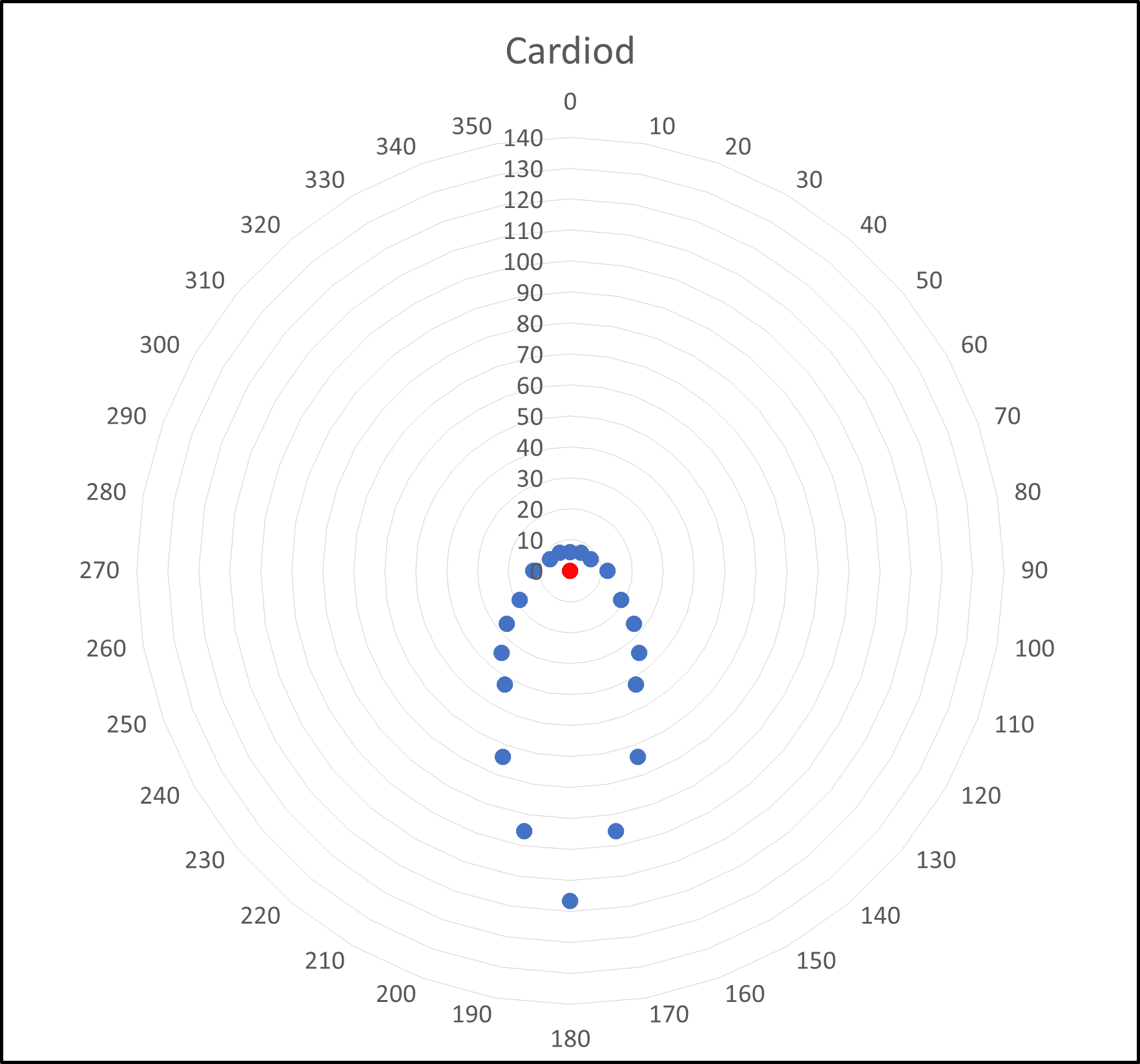
Cardioid Amplification
(Apparent Distance in Feet)
Microphone Pickup Patterns Super Cardioid & Hypercardioid
Most shotgun microphones are Supercardioid or Hypercardioid microphones. Their signal drops off more rapidly than a cardioid microphone as you move away from the centerline of the microphone. They also capture more sound directly behind the microphone than a cardioid mic. The images below show the polar pattern for typical Super Cardioid and Hypercardioid microphones, the Shure 87A and Neumann KM-185. Likewise, the blue curve shows how the signal level drops off as you move away from the centerline of the microphone.

Super Cardioid Polar Pattern
(Gain in dB)

Hypercardioid Polar Pattern
(Gain in dB)

Super Cardioid Polar Pattern
(Amplification)

Hypercardioid Polar Pattern
(Amplification)
Again, let’s imagine being in the center of a large room with people standing in a circle around you. Each person is exactly six feet from you as before.
The images below show how these people would sound to the Super Cardioid and Hypercardioid microphones. The red dot is the microphone and each person standing around the microphone is represented as a blue dot. To these microphones, it would appear that people 120 degrees off the centerline are over 100 feet away. People directly behind the microphone would appear to be approximately 20 feet away.
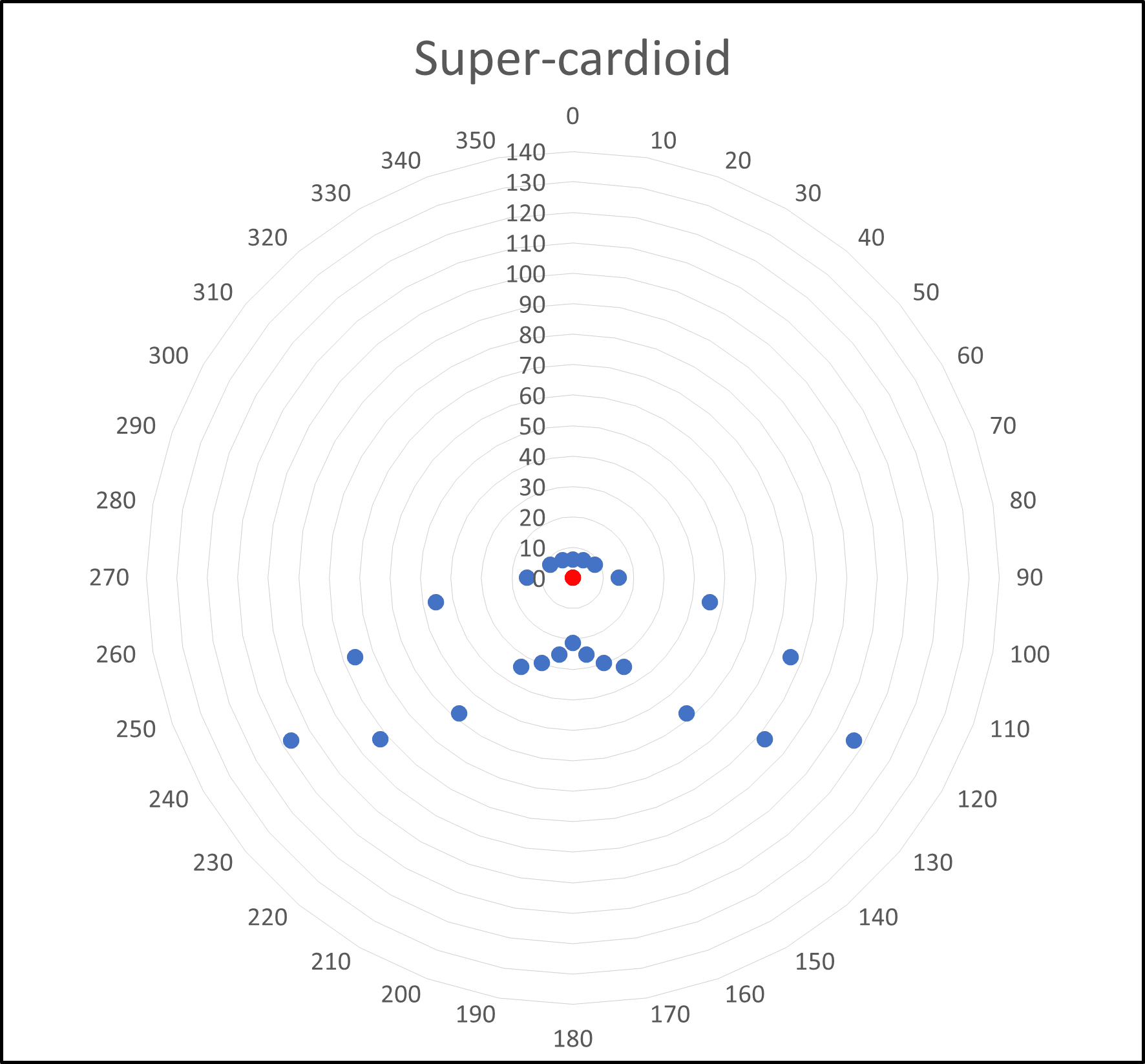
Super Cardioid Amplification
(Apparent Distance in Feet)

Hypercardioid Amplification
(Apparent Distance in Feet)
As previously mentioned, shotgun microphones typically have Super Cardioid or Hypercardioid pickup patterns. Shotgun mics are commonly used when capturing sound primarily from one direction!
Pickup Patterns: Lobar
Many high-end shotgun microphones have a lobar pickup pattern.
The signal drops off more rapidly than the supercardioid or hypercardioid microphones as you move away from the centerline of the microphone. They also capture less sound directly behind the microphone than those microphones. The image below shows a polar pattern for a typical lobar microphone, the Sennheiser ME66. The blue curve shows how the signal level drops off as you move away from the centerline of the microphone.
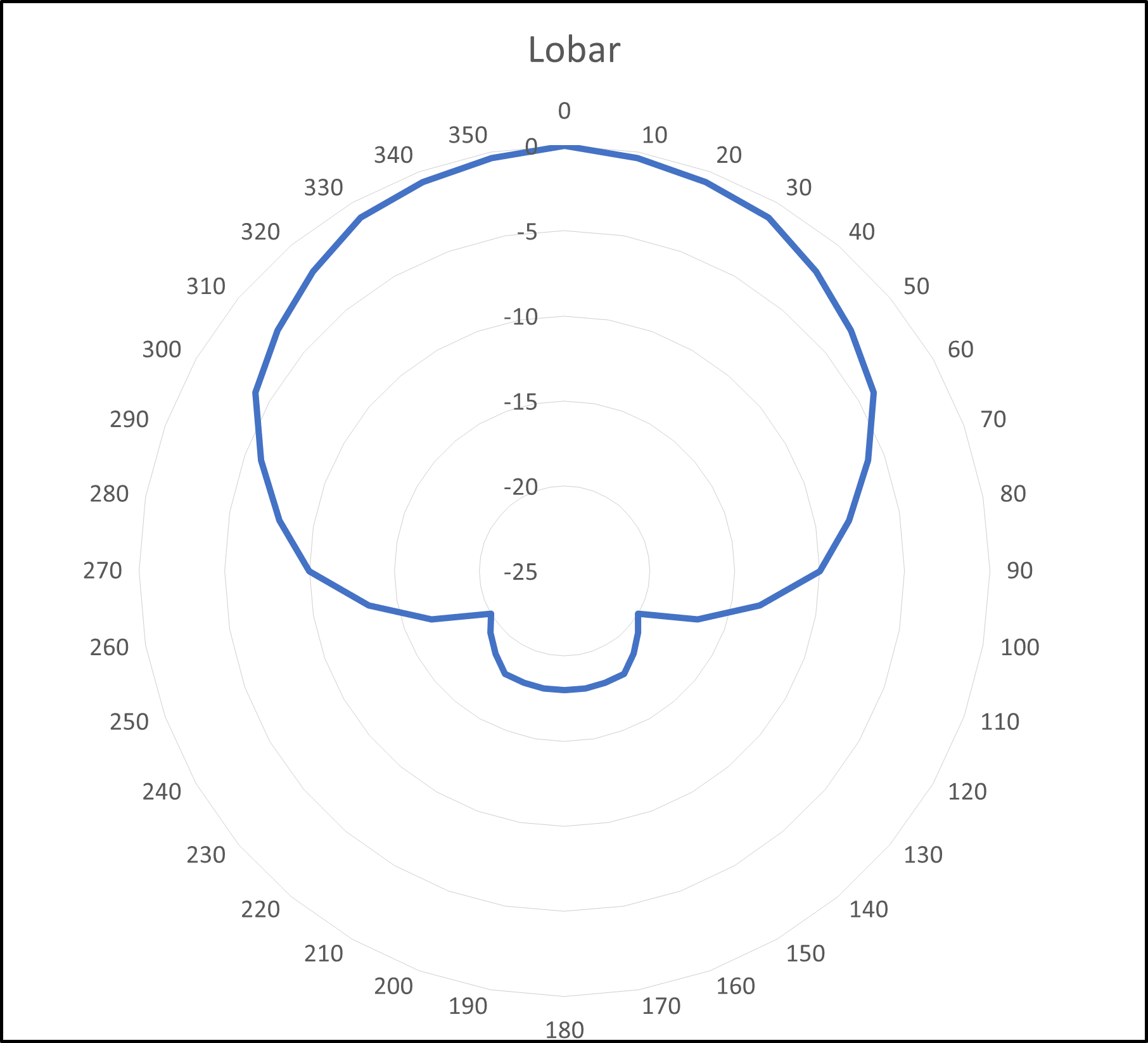
Lobar Polar Pattern
(Gain in dB)

Lobar Polar Pattern
(Amplification)
Let’s imagine, once again, being in the center of a large room with people standing in a circle around you. Each person is exactly six feet from you as before.
The image on the right shows how these people would sound to the lobar microphone. The red dot is the microphone and each person standing around the microphone is represented as a blue dot. To these microphones, it would appear that people 120 degrees off the centerline are approximately 60 feet away. People directly behind the microphone would appear to be approximately 50 feet away.

Lobar Amplification
(Apparent Distance in Feet)
If you desire a more directional, or more focused pickup pattern than a shotgun mic provides, a parabolic collector should be considered. Parabolic microphones are discussed at the end of this article.
Figure 8 Microphones:
Figure 8, or bidirectional microphones, are less prevalent than the other polar patterns but are still widely used. They capture sound from both the front and rear of the microphone but reject sound from the sides. The image below shows a polar pattern for a typical Figure 8 microphone, the Sennheiser MKH 30. The blue curve shows how the signal level drops off as you move away from the centerline of the microphone.

Figure 8 Polar Pattern
(Gain in dB)
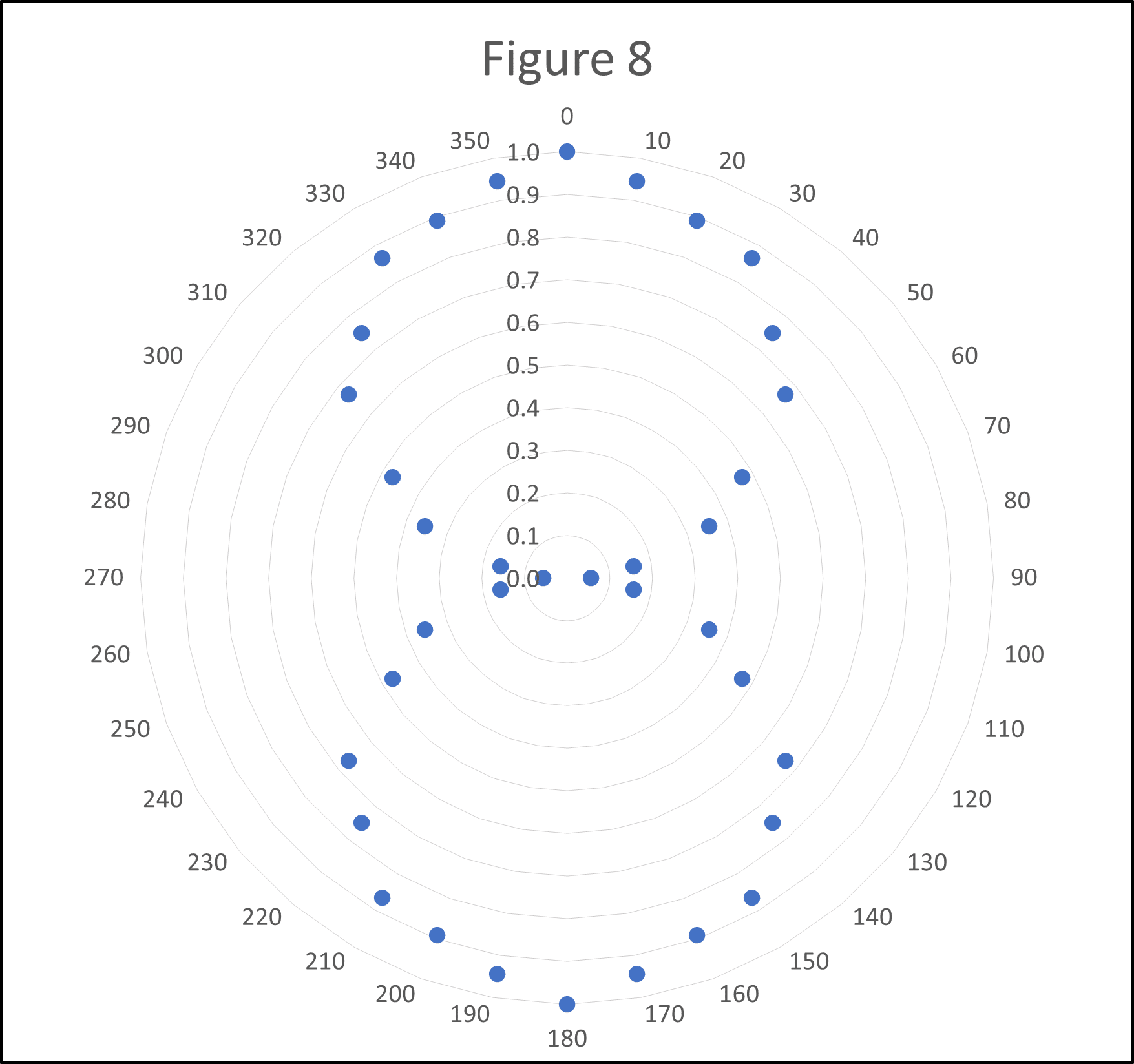
Figure 8 Polar Pattern
(Amplification)
Again, let’s imagine being in the center of a large room with people standing in a circle around you. Each person is exactly six feet from you as before.
The image below shows how these people would sound to the Figure 8 microphone. The red dot is the microphone and each person standing around the microphone is represented as a blue dot. To these microphones, it would appear that people 90 degrees off the centerline, in either direction, are over 100 feet away. People directly behind the microphone would appear to be just 6 feet away.
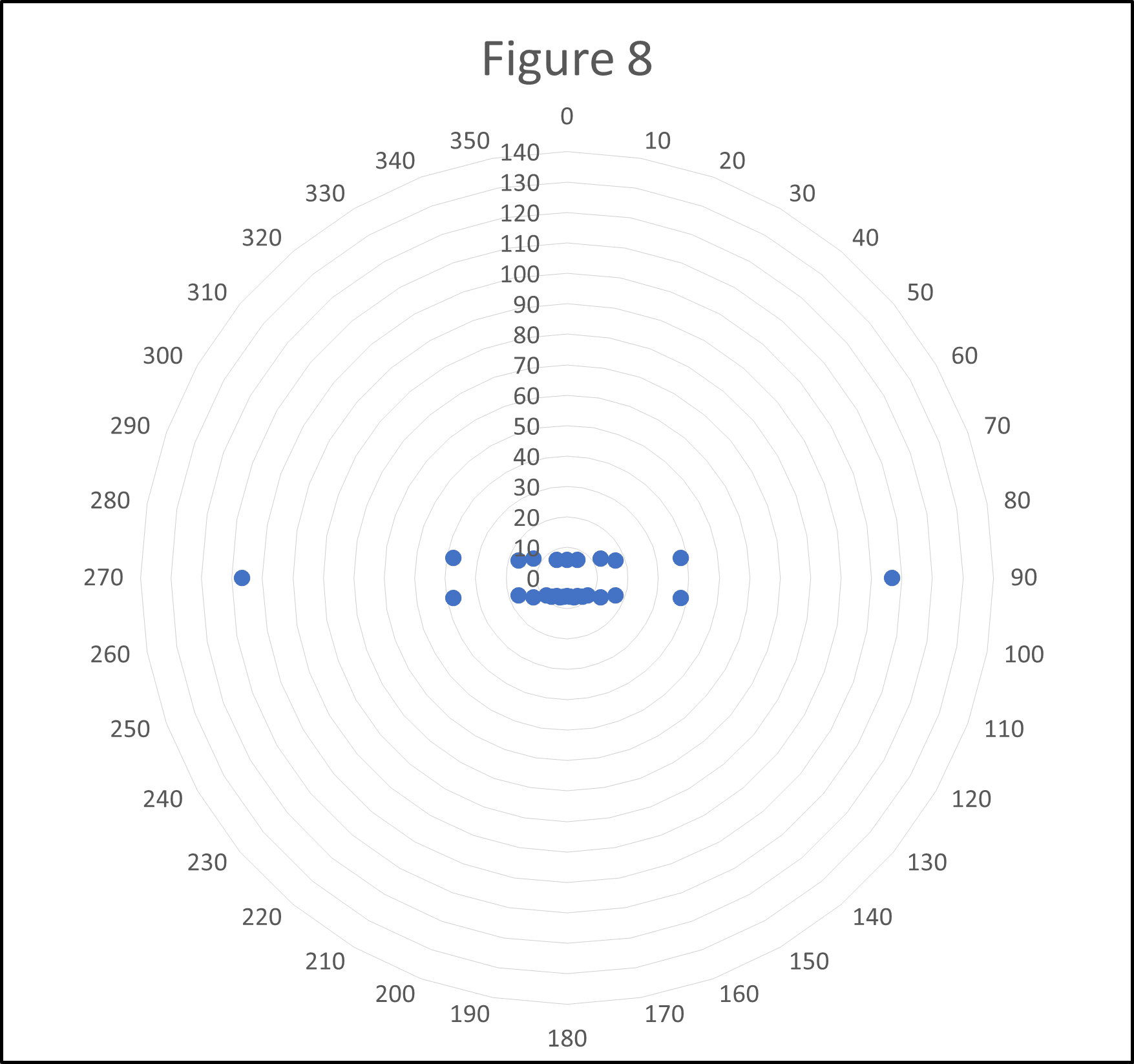
Figure 8 Amplification
(Apparent Distance in Feet)
The Figure 8 pickup pattern is used to capture two persons directly opposed to each other such as in an interview situation, or two instruments located on either side of the microphone. Ribbon microphones typically have a Figure 8 pickup pattern.
Multi-Pattern Microphones:
Multi-pattern microphones are the sixth option for a microphone’s pickup pattern as these microphones offer multiple pickup patterns within a single microphone. The pickup pattern is selected using a switch.
The Uncommon Pattern – Parabolic Microphones:
Parabolic microphones are actually the combination of a parabolic collector dish and a microphone. An omni-directional or cardioid microphone is typically placed inside a parabolic collector dish to create a device with an extremely directional pickup pattern.

Parabolic Mic Polar Pattern
(Gain in dB)

Parabolic Mic Polar Pattern
(Amplification)
One last time, let’s imagine being in the center of a large room with people standing in a circle around you. Each person is exactly six feet from you as before.
The image below shows how these people would sound to a parabolic microphone. The red dot is the microphone, and each person standing around the microphone represents a blue dot. To these microphones, it would appear that people 30 degrees off the centerline, in either direction, are over 40 feet away. People 120 degrees off the centerline, in either direction, would be 130 feet away. Lastly, people directly behind the microphone are 40 feet away.

Parabolic Mic Amplification
(Apparent Distance in Feet)
Because of their ability to collect, or amplify sound energy, parabolic microphones are used when long range is required. Also, they are used when a highly directional pickup pattern is needed.
To learn more about parabolic microphones, please refer to our article “What is a Parabolic Mic and How Does it Work?” or “What are the pros and cons of parabolic microphones?“.
For more information about our KLOVER MiK microphones, check out our store here.
We hope you found this article useful.
For more information on selecting the correct microphone for your needs, please feel free to contact us!

Bringing the Distant Near & Keeping Your Vision Clear.


Can Your Mic Reach As Far Your Lens?



Bringing the Distant Near & Keeping Your Vision Clear.


Clear Vision in Seconds, No Contact Required!












